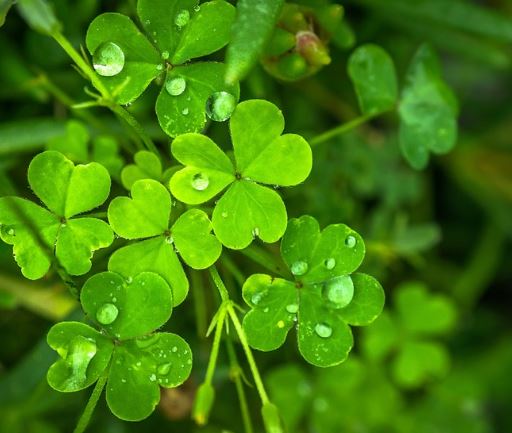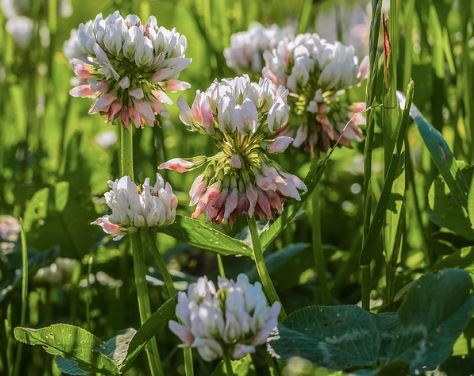
The new craze in environmentally conscious, heat-tolerant, and drought-tolerant landscaping is clover grass, which recently went viral on TikTok. But before you turn your turf into something a bit “greener,” you’ll want to see what professionals have to say about clover grass—and why they might be coming soon to a neighborhood near you.
Table of Contents
What Is Clover Grass?
Known for its shamrock-shaped leaves, clover grass is a thick ground cover. Some property owners decide to grow clover grass, specifically white clover, in their lawns along with other grass or turf. White clover, also called Dutch clover, is distinguished by its tiny white flowers, which grow best in warm southern climates. Others sow clover seeds, while some people simply give up fighting their clover and let nature take its course so that it can spread. It’s simple to look after and maintain once it grows. A vibrant and biodiverse lawn bursting with pretty white flowers is the end result.
How Many Types Of Clover Grass?
What’s the appearance of clover grass? There are numerous varieties of clover grass, most of which are visually comparable. Three tiny leaves in the shape of petals will grow on each clover stem, and if you’re lucky, four.) with a white “V” or crescent. Here are two of the best low-maintenance clover varieties for lawns.
Also called Trifolium repens or In contrast to micro clover, white clover grass typically grows to be taller. The most common clover seed for lawns, it can also be used as a ground cover, a perennial cover crop, and to prevent erosion. A clover grass’s scenery is dotted with its well-known round, fragrant, white flowers.
This dwarf variety of Dutch white clover grass grows more slowly than its relative, has smaller leaves, and produces fewer flowers. It differs from typical Dutch clover in that it doesn’t form clumps, it grows more slowly, and it is less aggressive when it comes to displacing other plants.

Why Is Clover Grass So Popular Right Now?
“What is a weed really,” asks Auburn University’s Dr. David Han, an expert in Alabama turf. “A weed is simply a plant you don’t want to be there.” Clover grass’s story can be changed by simply altering its goals and reputation.
Why now? “It appears to be continuing a 20-year-old trend, in my opinion. We are reducing our use of mowers, blowers, and other equipment while also creating a habitat for pollinators. We’re reducing our lawn maintenance and it’s a wonderful way to do it,” says Sustainable Horticultural Environments was created by Florida-based landscape designer Teresa Watkins. A lawn gains interest by cultivating clover. “Your traditional monoculture, one species of grass certainly has a bad reputation, particularly in the South. It’s not ‘in’ to be growing just one variety of something in a clover grass,” says Han, essentially, clover’s advantages are being recognized and followed by more and more people.
What Are the Pros Of Clover Grass?
1. With Clover Grass, You Can Mow Much Less Frequently.
Unlike the weekly mowing that is necessary for most grass lawns, a clover yard only needs to be mowed a few times per year. White clover grass only reaches heights of 2 to 8 inches, explaining why. Some housewives enjoy mowing their lawns in the middle of the season to tidy them up and deadhead flowers. There is no need to spend every weekend mowing as you would with turf, but having a mowed clover lawn in place 4 to 6 weeks prior to the first frost can help winterize your lawn.
2. Compared To Conventional Grass, Clover Grass Uses Less Water.
Clover grass lawns need less watering and less mowing than most other types of grass. This is so that even in northern hardiness zones, where it may not be able to survive droughts, clover grass may remain green all year.
In contrast, turfgrass needs at least an inch of water per week. Regular and vigorous watering can cause runoff of pesticides and other chemicals, which can pollute our waterways and harm wildlife in addition to wasting a valuable natural resource—water. Because clover grass has much deeper roots than turf, watering your lawn will take much less time and money if you plant clover instead of grass.
3. A Clover Grass Doesn’t Require Fertilization.
Due to the legume nature of clover, it absorbs nitrogen from the air and releases it into the soil, where it enhances the soil’s fertility and the health of the plants that grow nearby. As it can thrive in compacted or poorly draining soil, clover grass is a benefit for yards with poor soil.
It won’t be necessary to fertilize the grass because there will be a mix of grass and clover grass on your lawn. Both additional fertilizer and clover grass don’t need it!

4. Clover Grass Isn’t As Resilient As Grass In Locations With A Lot Of Foot Traffic.
Clover grass doesn’t hold up well to repeated heavy foot traffic or playing fields by itself, but when combined with turfgrass, it can create a strong lawn and withstand sporadic heavy traffic. In heavily trafficked areas, white clover ground cover can appear patchy and bare. Clover stains clothes more than turf, which is one of its few drawbacks. Its short lifespan makes it perennial and, as such, may necessitate reseeding every two to three years.
5. With A Clover Grass, Neither Pesticides Nor Herbicides Are Required.
Herbicides are not necessary on clover grass because white clover (also known as Dutch clover) crowds out weeds thanks to its deep roots and rapid growth. Herbicides should be avoided because the majority of them kill clover. It outcompetes broadleaf weeds and forms dense clumps that disperse via their secondary roots, making clover grass an effective herbicide in and of itself.
Applying pesticides to clover grass is not advised due to the fact that it also draws beneficial wildlife, such as rabbits, and insects, such as pollinators. Broad-spectrum pesticides and herbicides, particularly synthetic pesticides, can be toxic to humans and animals and have a negative impact on the local ecosystems and waterways.
RELATED: 15 Natural Pest-Control Strategies for Your Home Landscape
6. The Cost Of Clover Grass Seed Is Very Low.
An average pound of white clover grass seed for lawns costs around $4. This implies that 1,000 square feet of seed can be planted for as little as $1. Comparing clover grass seed to many common grass varieties, it can be more affordable due to the fact that it requires less watering, mowing, and pest control.
7. Clover Grass Can Proliferate With Little Upkeep.
Will clover grass supplant grass? Clover may invade areas of your lawn where the grass is sparse or brown, especially if those areas are shaded. Clover grass, on the other hand, adds nitrogen to the soil, so it is more likely to aid in the maintenance of your grass’ health than to harm it or cause it to compete with other parts of your lawn.
8. With A Clover Grass, Aeration Is Not Necessary.
Regular core aeration is beneficial to turf, but it takes a lot of time to do it yourself, or is expensive to have a lawn care company do it for you. Clover grass is thought of as a living mulch that feeds the soil nutrients and prevents compaction. Micropores are left behind in the soil by decomposing clover roots. These draw earthworms, which maintain the soil’s elasticity (and prevent the need for aeration) and lessen the buildup of thatch.

9. Beneficial Insects Are Drawn To Clover Grass.
Bees, as well as other pollinators like butterflies, are drawn to lawns with clover. As a result of habitat loss and pesticide use, many of these species—many of which are essential to our survival—are becoming extinct.
The disadvantage is that there’s a slight possibility that you or your kids could unintentionally step on a bee and get stung if you or they frequently walk barefoot. Plant micro clover, which bears fewer flowers than Dutch white clover, to avoid this or cut the grass before the flowers bloom. The advantage of giving pollinators food and shelter, however, is lost when flowers are cut down.
10. Compared To Most Grasses, Clover Grass Is More Drought And Shade Tolerant.
Clover grass is semi-evergreen or evergreen, depending on the region, and prefers full sun to some shade in order to thrive. Others become spindly in light shade, while some turfgrasses scorch in the summer sun.
If the plants are spaced apart, white clover grass is a moderately drought-tolerant ground cover. They often compete for water if they are planted too close together. They perform worse during droughts in that situation. This is one of the reasons why clover grass grows so well when combined with grass. The shade that clover gives the ground helps the grass withstand dry spells and reduces water evaporation.
11. The Ground Is Soft On Clover, And Pet Urine Doesn’t Stain It.
Clover grass is soft and cool, providing a “carpet” for barefoot walkers. That encourages grounding or earthing, which studies show is good for human health because the electrical connection with the earth restores the immune system, much like antioxidants do. The sweet scent that comes off the flowers makes them even more alluring.
Dogs also have to go when they need to relieve themselves. Clover grass won’t be affected by dog urine and will continue to be green and beautiful, whereas most grasses can become discolored by it.
How To Plant A Clover Grass
Despite the fact that clover grass occasionally reproduces by seeding itself, it’s still helpful to know how to plant it because you might need to do so every two to three years.
To give clover grass seed time to establish before cold weather arrives, start in the early spring (mid-March to mid-April). Follow these simple steps on how to grow a clover lawn:
- Remove the grass from your lawn to remove competition if you want an all-clover yard. Seed the clover on top of the grass if you want a mixed-grass lawn.
- The area where you want to plant should be raked or scratched.
- Spread 6 to 8 ounces of clover grass seed per 1,000 square feet. Because the seeds are tiny, try your best to keep them distributed evenly throughout your lawn.
- After seeding, water the soil lightly or mist it frequently until the clover grass takes root.
- Clover grass doesn’t require fertilizer, so avoid doing it.
Now you know everything about clover grass, start to grow your clover grass.